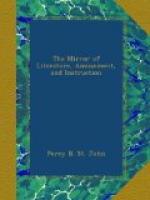Naturalists, especially those of France, were long induced to suspect the truth of Bruce’s description of this animal; but a specimen from the interior of Nubia, and preserved in the museum at Frankfort, has recently been engraved; and thus the matter nearly settled by the animal belonging to the genus Canis, and the sub genus Vulpes; the number of teeth and form, being precisely the same as the fox, which it also resembles in its feet, number of toes, and form of tail.
For the above engraving we are indebted to the Appendix to the important and interesting Travels of Messrs. Denham and Clapperton. It is therein described as generally of a white colour, inclining to straw yellow; above, from the occiput to the insertion of the tail it is light rufous brown, delicately pencilled with fine black lines, from thinly scattered hairs tipped with black; the exterior of the thighs is lighter rufous brown; the chin, throat, belly, and interior of the thighs and legs are white, or cream colour. The nose is pointed, and black at the extremity; above, it is covered with very short, whitish hair inclining to rufous, with a small irregular rufous spot on each side beneath the eyes; the whiskers are black, rather short and scanty; the back of the head is pale rufous brown. The ears are very large, erect, and pointed, and covered externally with short, pale, rufous brown hair; internally, they are thickly fringed on the margin with long grayish white hairs, especially in front; the rest of the ears, internally, is bare; externally, they are folded or plaited at the base. The tail is very full, cylindrical, of a rufous brown colour, and pencilled with fine black lines like the back. The fur is very soft and fine; that on the back, from the back to the insertion of the tail, as well as that on the upper part of the shoulder before, and nearly the whole of the hinder thigh, is formed of tri-coloured hairs, the base of which is of a dark lead colour, the middle white, and the extremity light rufous brown.
[Footnote 3: We did not know that such unpleasantries as Chancery injunctions were part of African law; perhaps sand may not be removed from the desert “without leave of the trustees,” like scrapings from our roads.]
Fossil Turtle.
A beautiful and perfect fossil of the sea turtle has recently been discovered in an extensive stratum of limestone, four fathoms water, called the Stone Ridge, about four miles off Harwich harbour. It is incrusted in a mass of ferruginous limestone, and weighs 180 lbs.
Apples.
A gentleman of Staffordshire recommends the preservation of apples for winter store, packed in banks or hods of earth like potatoes.— Communication to the Horticultural Society.
Uses of Seals.




